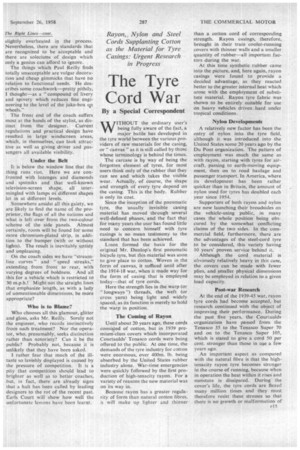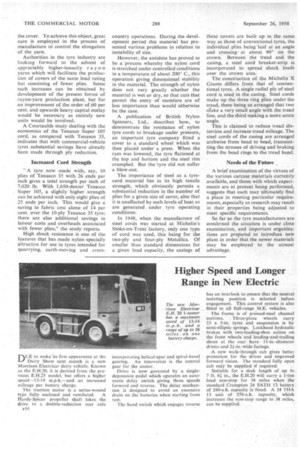The Tyre Cord War
Page 129

Page 130

If you've noticed an error in this article please click here to report it so we can fix it.
By a Special Correspondent
W[MOUT the ordinary user's being fully aware of the fact, a major battle has developed in the tyre world between the various providers of raw materials for the casing, or " canvas "as it is still called by those whose terminology is behind the times. . The carcase is by way of being the forgotten element of tyres, for most users think only of the rubber that they can see and which takes the visible wear. Actually, of course, the shape arid strength of every tyre depend on the casing. This is the body. Rubber is only its coat.
Since the inception of the pneumatic tyre, the usually invisible casing material has moved through several well-defined phases, and the fact that for many years the user has found little need to concern himself with tyre casings is no mean testimony to the standard that has been achieved.
Linen formed the basis for the original Mr. Dunlop's first pneumatic bicycle tyre, but this material was soon to give place to cotton. .Woven in the form of canvas, it sufficed until after the 1914-18 war, when it made way for the form of casing that is employed today—that of tyre cords.
Here the strength lies in the warp (or "longways ") threads, the weft (or cross yarn) being light and widely spaced, as its function is merely to hold the warp in position.
The Coming of Rayon
Until about 20 years ago, these cords consisted of cotton, but in 1939 premium-class covers which incorporated Courtaulds' Tenasco cords were being offered to the public. At one time, the demands of the tyre industry for cotton were enormous, over 400m. lb. being absorbed by the United States rubber industry alone. War-time emergencies were quickly followed by the first production of high-tenacity rayon. For a variety of reasons the new material was on its way in.
Because rayon has a greater regularity of form than natural cotton fibres, it will make up lighter and thinner than a cotton cord of corresponding strength. Rayon casings, therefore, brought in their train cooler-running covers with thinner walls and a smaller quantity of rubber—all important factors during the war.
At this time synthetic rubber came into the picture, and, here again, rayon casings were found to provide a decided advantage, as they reacted better to the greater internal heat which arose with the employmentof substitute material. Rayon tyre fabric was shown to be entirely suitable for use on heavy vehicles driven hard under tropical conditions.
Nylon Developments
A relatively new factor has been the entry of nylon into, the tyre field, although it was introduced into the United States some 20 years ago by the Du Pont organization. The pattern of employment was much the same as with rayon, starting with tyres for aircraft, -passing to earth-moving equipment, then on to road haulage and passenger transport. In America, where its development has been rather quicker than in Britain, the amount of nylon used for tyres has doubted each year since 1954.
Supporters of both rayon and nylon are now launching their broadsides on the vehicle-using public, in many cases the whole position being obscured by the somewhat conflicting claims of the two sides. In the commercial field, furthermore, there are the advantages of the steel-cord tyre to be considered, this variety having 10 years' proven service behind it.
Although the cord material is obviously relatively heavy in this case, the covers can be made with fewer plies, and smaller physical dimensions may be employed in relation to a given load capacity.
Post-war Research
At the end of the 1939-45 war, rayon Lyre cords had become accepted, but research continued with the object of improving their performance. During the past five years, the Courtaulds organization have passed from the Tenasco 35 to the Tenasco Super 70 and on to the Tenasco Super 105, which is stated to give a cord 50 per cent. stronger than those in use a few years" ago.
An important aspect as compared with the natural fibre is that the hightenacity rayon tyre becomes stronger in the course of running, because when in operation the heat within it rises and moisture is dissipated. During the cover's life, the tyre cords are flexed many million times and they must therefore resist these stresses so that there is no growth or malformation of
the cover. To achieve this object, great care is employed in the process of manufacture tocontrol the elongation of the yarn.
Authorities in the tyre industry are looking forward to the advent of appreciably higher-tenacity rayon yarns which will facilitate the production of coversof the same load rating but consisting of fewer plies. Some such increases can be obtained by development of the present forms of rayon-yarn production plant, but for an improvement of the order of ,60 per cent. and upwards heavy capital outlay would be necessary as entirely new units would be involved.
A Courtaulds study dealing with the economics• of the Tenasco Super 105 cord, as compared with Tenasco 35, indicates that with commercial-vehicle tyres substantial savings have already been made through ply reduction.
Increased Cord Strength "A tyre now made with, say, 10 plies of Tenasco 35 with 26 ends per inch gives a total strength per inch of 7,020 lb. With 1,650-denier Tenasco Super 105, a slightly higher strength can be achieved with only eight plies of 25 ends per inch. This would give a saving in fabric cost alone of 14 per cent, over the 10-ply Tenasco 35 tyre: there are also additional savings in labour costs and overheads associated' with fewer plies," the study reports.
High shock resistance is one of the features that has made nylon specially attractive for use in tyres intended for quarrying, earth-moving and cross
country operations. During the development period this material has presented various problems in relation to instability of size.
However, the antidote has proved to be a'process whereby the nylon cord is stretched under controlled conditions in a temperature of about 200° C., this operation giving dimensional stability in the material. The strength of nylon does not vary greatly whether the material is wet or dry, so that cuts that permit the entry of moisture are of less importance than would otherwise be the case.
A publication of British Nylon Spinners, Ltd., describes how, to demonstrate the resistance of nylon tyre cords to breakage under pressure, an important tyre company fitted a cover to a standard wheel which was then placed under a press. When the ram was lowered, the tyre flattened at the top and bottom and the steel rim crumpled. But the 'tyre did not suffer a blow-out.
The importance of steel as a tyrecord material lies in its high tensile strength, which obviously permits a substantial reduction in the number of plies for a given size of cover, also that it is unaffected by such levels of heat as are generated under tyre operating conditions.
In 1948, when the manufacture of steel cords was started at Michelin's Stoke-on-Trent factory, only one type of cord was used, this being for the two-ply and four-ply Metallics. Of smaller than standard dimensions for a given load capacity, the casings of these covers are built up in the same way as those of conventional tyres, the individual plies being'laid at an angle and crossing at about 90° on the crown. Between the tread and the casing, a steel cord breaker-strip is incorporated . to spread shock loads over the crown area.
The construction of the Michelin X Giants ,differs from that of conventional tyres. A single radial ply of steel cord is Used in the easing. Steel cords make up the three ring Plies under the tread, these being so arranged that two niake a very small angle with the tread line, and the third making a more acute angle.
This is claimed to reduce tread distortion and increase tread mileage. The steel cords of the easing are arranged archwise from bead to bead, transmitting the stresses of driving and braking from the bead-rings to the tread band.
Needs of the Future
A brief examination of the virtues of the various carcase materials currently avail'able, and those with which experiments are at present being performed, suggests that each may ultimately find a place in meeting particular requirements, especially as research may result in their properties being adjusted to meet specific requirements.
So far as the tyre manufacturers are concerned the situation is under close examination, and important organizations are prepared to introduce new plant in order that the newer materials may be employed to the utmost advantage.












































































































































































































































































































































